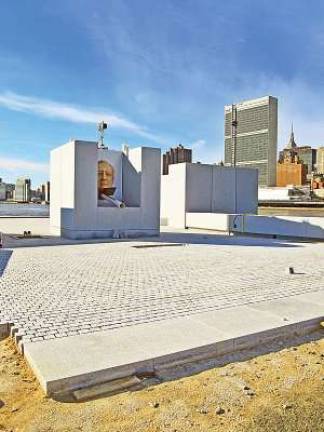Roosevelt Legacy Honored in New Park

By Sean Creamer
What was once an obscure stretch of land known as "Welfare Island," home to smallpox cases, is being reimagined as a monument to the president who led Americans out of the Great Depression.
Franklin D. Roosevelt Four Freedoms Park, expected to open fall 2012 at the tip of Roosevelt Island was first envisioned by the Franklin and Eleanor Roosevelt Institute in the early 1970s. The concept was brought to architect Louis I. Kahn, who worked on the Yale University Art Gallery in New Haven, Conn., and Salk Institute for Biological Studies in La Jolla, Calif.
Kahn drafted plans for the park and made several drawings but died in 1974 in a men's room at Penn Station. His death, coupled with the economic turmoil of the times and Gov. Nelson A. Rockefeller, a major advocate of the project, being called to Washington, D.C., to serve as vice president under Gerald Ford, led to its abandonment.
After four decades, the project began anew with backing from former U.S. Ambassador William vanden Heuvel, who found out that the governing force on the island, the Roosevelt Island Operating Committee, was planning to build another park on the 4.5-acre stretch of land.
The exterior of a room at the end of park will feature a niche housing a sculpture of Franklin Roosevelt's head made by sculptor Jo Davidson in 1933.
The four freedoms that are celebrated in the park are freedom of speech and expression, freedom of worship, freedom from want and freedom from fear. These ideals will be illustrated on the walls behind the niche.
The walls of the room are 12-foot-tall granite slabs weighing 36 tons apiece. The monolithic slabs are spaced an inch apart and the walls inside the space are polished so that reflected light will play on the floor and walls of the room.
Opposite the entrance is an open window that displays a view of the East River and the United Nations.
Kahn designed the project around a room because a room is a place where people meet and trade stories, where "secrets are told and treaties signed," said Sally Minard, CEO of the Franklin D. Roosevelt Four Freedoms Park LLC.
"His concept of architecture is that everything starts in a room," Minard said.
The park is shaped like the bow of a ship, with Kahn's room at the tip. The room is a constant focal point, a key design by Kahn, and is visible from the park's garden and the flanking promenades.
The garden will be lined by two allées lined with 150 linden trees. The allées will feature inscriptions called Roosevelt Legacy Chapters, or Chapters of History. The project will also feature a digital education program that will turn a stroll into a lesson in Roosevelt-era history. Using their smart phones, patrons of the park will be able to call up mini-documentaries about each story inscribed upon the park's granite parapets.
Below the garden are two promenades that meet at the entrance to the room. The banks of the promenade are pieced together by granite in a fashion that resembles a puzzle. At the entrance to the memorial is a grand staircase hidden behind a jardinière that will hold five copper beech trees.
The cost of the project so far is $50 million.